When Robin W.G. Stephens applied to join the Security Service, he claimed to have been awarded the Star of Abyssinia medal for his service with the Red Cross during the Second Italo-Abyssinian War in the mid-1930s. The funny thing is… there is no such medal in the United Kingdom. A mystery calling out for investigation.

May 2014 Medal News
In 2014, Chris Bilham wrote an article about Stephens and his medals for the May edition of Medal News. He had in his possession a medal which he believed was Stephens’ India General Service Medal (plus clasps). He included a photograph of the medal along with the other medals awarded to Stephens (seven in total). I was perplexed because the well-known picture of Stephens (above) shows ribbons for eight medals on his ribbon bar, yet Chris only featured seven medals. Another mystery.
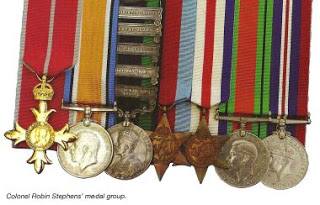
I reached out to Chris via email and he told me that he had purchased the India General Service Medal from a dealer in England sometime in the 1990s. At the time, neither he nor the dealer knew much about Stephens, only that his name was inscribed on the edge of the medal and that he had been a 2nd Lt. By the 2010s, more information on Stephens was surfacing and Chris decided to write up a piece about Stephens for Medal News. He deciphered the medals awarded to Stephens based on the black and white photograph, quite a feat I think. He noted that “the second ribbon is certainly the British War Medal, awarded for service in World War I. Stephens did not fight in that war, but he did leave his own country and serve in uniform (under training), so did qualify.” As for the last ribbon, Chris admitted that it was a puzzle. He thought it might be the Territorial Decoration. “Stephens certainly did not qualify for this, but he was listed as an officer in the Territorial Army when his name was published in the Gazette for official announcements, so he might have worn the ribbon as part of his cover.” Given the uncertainty around the final ribbon, Chris did not add it to the photo replicating Stephens’ medal grouping. So, one mystery solved.
Stephens’ Medal Grouping
Given that Chris published his article in a magazine devoted to medals, regular readers of the magazine could likely decipher the medals just be looking at the above photograph. Not being a medal aficionado… I was only able to identify four at a glance. The medals pictured above are:
- Order of the British Empire (OBE)
- British War Medal (1914-1918, extended to 1920 for some theaters )
- India General Service Medal with oak leaves (MiD) and five clasps (click this link for a closer look at the medal and its clasps)
- Afghanistan N.W.F. 1919
- Waziristan 1919-21
- Mahsud 1919-20
- Malabar 1921-22
- Waziristan 1921-24
- M.I.D. oak leaves
- 1939-1945 Star
- France and Germany Star
- Defence Medal
- War Medal 1939-1945
I zoomed in on Stephens’ ribbon bar and matched up the grey-scale ribbons with the ones identified by Bilham. They appear to be accurate and one can see the final ribbon (bottom right) appears to be three vertical colour bands of equal width, none overly dark so likely not blue or black. The middle band of the last ribbon seems to be of a slightly lighter shade than the left and right banks. Given that it is the last slot, I wondered if the United Kingdom’s “Order of Wear” might be helpful.
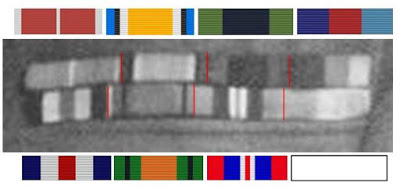
The “Order of Wear” for British military awards and decorations is as follows. I have added Stephens’ medals in order and highlighted them to demonstrate that they follow the order of wear:
- Victoria Cross and the George Cross
- British Orders of Knighthood – includes the OBE
- Decorations, Medals for Gallantry and Distinguished Conduct
- Badge of Honour
- Campaign Medals and Stars (including authorised United Nations medals and medals of other recognised international organisations). Worn in order of date of award. According to the Gazette, the order for WW1 is: 1914 Star, 1914-15 Star, British War Medal, Mercantile Marine War Medal, Victory Medal, Territorial Force War Medal. We would then have Stephens’ interwar India General Service Medal followed the medals for WW2: 1939-1945 Star, Atlantic Star, Arctic Star, Air Crew Europe Star, Africa Star, Pacific Star, Burma Star, Italy Star, France & Germany Star, Defence Medal, Canada Volunteer Service Medal, Newfoundland Volunteer War Service Medal, War Medal, Africa Service Medal, India Service Medal, New Zealand War Service Medal, Southern Rhodesia Service Medal, Australian Service Medal
- Polar Medals
- Imperial Service Medals
- Police Medals for Valuable Service
- Jubilee, Coronation and Durbar Medals
- Efficiency and Long Service Decorations and Medals
- Commonwealth Realm’s Orders, Decorations and Medals
- Other Commonwealth Members Orders, Decorations and Medal
- Foreign Orders, Decorations and Medals (If approved for wear, worn in order of date of award)
Given that the last identifiable ribbon on Stephens’ ribbon bar is the War Medal 1939-1945, a campaign medal, the final ribbon could belong to any Order of Wear category after that. Which isn’t all that helpful as there are a lot of medals in the last seven categories! Chris had thought it might be the Territorial Decoration, let’s take a closer look.
Territorial Decoration

The Territorial Decoration was awarded for twenty years of service in the Territorial Army. Recipients were entitled to use the initials “TD” behind their names. In 1930, it was replaced by the Efficiency Decoration although Territorial Army recipients could still use “TD” behind their names. Stephens’ MI5 colleague William Edward Hinchley Cooke was awarded the Efficiency Decoration as he too served in the Territorial Army. In 1945, for example, a Gazette notice for Hinchley Cooked had “OBE, TD” behind his name.
The ribbon for the Efficiency Decoration is three vertical coloured bands with the centre band being yellow and the flanking bands being a forest green. I suppose this might be an option although on the grey-scale image of Stephens’ ribbon bar it looks as if the right and left bands are two different shades of grey.
I thought that the auto-colorized image might help tip the scales….
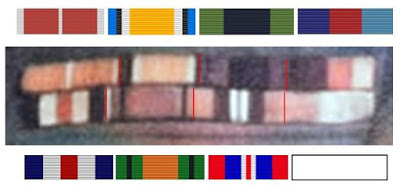
I’m not sure it helps all that much. The colour families are a bit too skewed by the auto-colorizing to be reliable. Although it does appear as if the final ribbon has three different colour shades which would tend to rule out the Efficiency or Territorial Decoration. On top of that,the three vertical banks look of equal width while the centre band in the Efficiency or Territorial Decoration is only half the width of either flanking band.
Which brings us back to Stephens assertion that he had been awarded the Star of Abyssinia. Deserving of more investigation.
Star of Abyssinia
The only Abyssinia medal awarded by the United Kingdom was the the Abyssinian War Medal, awarded in 1869 for those who participated in the 1868 Expedition to Abyssinia and served between 4 October 1867 and 19 April 1868. This is obviously not an option for Stephens’ medal since he was only born in 1900.
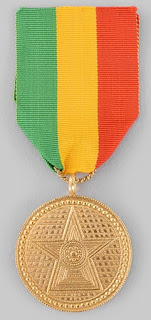
But, it got me thinking, the final category of medals in the Order of Wear is Foreign Orders, Decorations and Medals. Could the final ribbon belong to this category? Abyssinia was an old term for Ethiopia so what if the Star of Abyssinia was actually the Star of Ethiopia? Believe it or not, such a medal actually exists!
The Order of the Star of Ethiopia was established as an order of knighthood of the Ethiopian Empire, founded by the Negus of Shoa and later Emperor of Ethiopia Menelik II in 1884–1885. It is currently awarded as a house order by the Crown Council of Ethiopia.
The Order was established to honour foreign and domestic civilian and military officials and individuals for service to the country [emphasis added], and is considered the fifth ranking order of the Empire of Ethiopia alongside the Order of Menelik II.
All grades of the Order are approved for wear as a foreign order (i.e. after all British and other Commonwealth decorations) by Elizabeth II, Queen of the United Kingdom and the other Commonwealth realms, as it is on the “Schedule of Approved Countries and Awards”. Elizabeth II herself was awarded the Chain and Collar of the Order of the Seal of Solomon.
This medal would seem to be a fit as an award for Stephens’ time in Ethiopia with the British Red Cross. Stephens was quoted in numerous newspapers condemning the Italian’s use of mustard gas in the war and he himself was apparently wounded during a mustard gas attack.

The ribbon for the Star of Ethiopia is three vertical colour bands of equal width, green yellow and red. This is a definite possibility for the final ribbon on Stephens’ ribbon bar, albeit hard to determine in grey-scale!
Including the Star of Ethiopia ribbon on Stephens’ ribbon bar, we have:
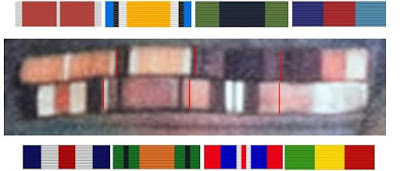
The auto-colorizer didn’t do a great job on the medal ribbons so it’s really hard to say if the ribbon for the Star of Ethiopia is a match or not. But, I think it’s a strong contender given Stephens’ assertion that he was awarded the Star of Abyssinia.
On the other hand, the source for Stephens’ claim to the Star of Abyssinia is Oliver Hoare’s introduction to Camp 020: MI5 and the Nazi Spies. Hoare gives no source for this information and when I tracked him down a few years ago, his memory of researching the book was a bit hazy. As far as he could remember, all of the material in the book was sourced from the National Archives. Which makes one wonder if Stephen’s MI5 application is tucked away in an unreleased file at Kew.
As a final closing comment, I should note that Stephens’ India General Service Medal is surrounded by a bit of a controversy. Apparently Stephens sold his medals in the early to mid-1930s, presumably when he declared bankruptcy. After the outbreak of the Second World War, it would appear that Stephens applied for, and received, a duplicate set of medals. Which means that there are two India General Service medals with Stephens’ name inscribed on the edge. But that is another blog post.
Sources
The Gazette – Order of Wear
May 2014 edition of Medal News – article by Chris Bilham – Spotlight: Two Gurhka Officers – Part II, p. 28-31.
